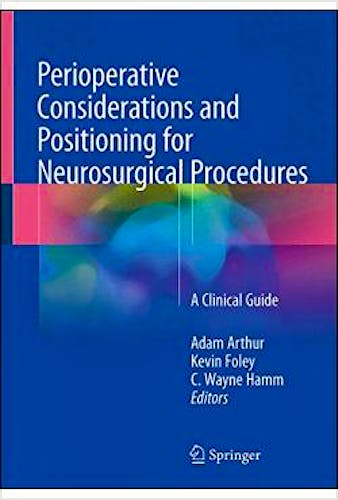

No hay productos en el carrito



Perioperative Considerations and Positioning for Neurosurgical Procedures. A Clinical Guide
Arthur, A. — Foley, K. — Hamm, C.
1ª Edición Marzo 2018
Inglés
Tapa dura
287 pags
812 gr
19 x 26 x 2 cm
ISBN 9783319726786
Editorial SPRINGER
LIBRO IMPRESO
-5%
135,19 €128,43 €IVA incluido
129,99 €123,49 €IVA no incluido
Recíbelo en un plazo de
2 - 3 semanas
LIBRO ELECTRÓNICO
-5%
103,99 €98,79 €IVA incluido
99,99 €94,99 €IVA no incluido
Acceso On Line
Inmediato
PREFACE FOREWORD CONTENTS 1. Positioning Patients for Neurosurgical Procedures, A Historical Perspective Mallory Roberts and Jon. H. Robertson 2. Biomechanics and the Mathematics of Positioning George F Young 3. Anesthesia and Patient Positioning C. Wayne Hamm 4. Preoperative Assessment of the Patient for the Planned Position C. Wayne Hamm and Jaafar Basma 5. Organization of the Operating Room for Neurosurgical Procedures Jaafar Basma and Daniel Hoit 6. Overall Positioning Considerations for Intracranial Procedures Adam S. Arthur 7. Intracranial Procedures in the Supine, Semi-Sitting and Sitting Positions Jaafar Basma, Vincent Nguyen, and Jeffrey Sorenson 8. Intracranial Procedures in the Lateral Position L. Madison Michael II and Douglas R. Taylor 9. Intracranial Procedures in the Prone Position Mirza Pojskicand Kenan I. Arnautovic 10. Spinal Surgery Positioning Overview Kevin T. Foley 11. The Supine, Sitting, and Lithotomy Positions Shaheryar F Ansari and Jean-Pierre Mobasser 12. Spinal Procedures in the Lateral Position Matthew T. Brown, Raul Cardenas, and Julius Fernandez 13. Spinal Procedures in the Prone Position Prayash Patel and Christopher Nickele 14. Special Considerations in Positioning for Neurosurgical Tumors: Spinal Jason Weaver 15. Special Considerations for Intracranial Tumors Pascal O. Zinn and Ganesh Rao 16. Special Considerations for Pediatric Positioning for Neurosurgical Procedures Michael DeCuypere 17. Co-Morbidities and Positioning: Morbid Obesity and Multiple Trauma Emily P. Sieg, and Shelly D. Timmons 18. Co-morbidities and Positioning: Pregnancy Thomas Scott Guyton 19. Post Operative Positioning in the Neurointensive Care Unit Abhi Pandhi and Lucas Elijovich 20. Differential Diagnosis, Treatment and Prognosis of Peripheral Nerve Injuries Associated with Neurosurgical Procedures Nickalus R. Khan and Michael S. Muhlbauer 21. Legal Issues in Patient Positioning Emily Hamm Huseth
There are relationships that exist between neuroanesthesia, neurosurgical procedures, individual patient pathology and the positioning of a patient for said procedure. A comprehensive examination of these relationships, their association with patient morbidity/mortality and how to approach these issues in an evidence-based manner has yet to become available. Positioning related injuries have been documented as major contributors to neurosurgical/neuroanesthesiology liability.This text examines these relationships. It provides considerations necessary to the correct positioning of a patient for a neurosurgical procedure for each individual patient and their individual pathology. In other words, this text will demonstrate how to construct the necessary surgical posture for the indicated neurosurgical procedure given the individual constraints of the patient within the environment of anesthesia and conforming to existing evidence-based practice guidelines. Sections will address physiological changes inherent in positioning in relation to anesthesia for neurosurgical procedures, assessment of patient for planned procedure, as well as considerations for managing problems associated with these relationships. Additional sections will examine the relationship between neurosurgical positioning and medical malpractice and the biomechanical science between positioning devices and neurosurgical procedures.Neurosurgery and its patient population are in a constant state of change. Providing the necessary considerations for the neurosurgical procedure planned under the anesthesia conditions planned in the position planned, often in the absence of multicase study literary support, without incurring additional morbidity is the goal of this text.
Adam S. Arthur MD MPH FAANS FAHA FACS. Professor of Neurosurgery University of Tennessee Health Sciences Center Semmes-Murphey. Neurological and Spine Clinic Memphis, TNUSA
Kevin T. Foley, MD, FACS Professor of Neurosurgery, Orthopaedic Surgery, & Biomedical Engineering. University of Tennessee Health Science Center. Chairman, Semmes-Murphey ClinicMemphis, TN USA C.
Wayne Hamm CRNA, MSN, APNGermantown, TN USA
© 2025 Axón Librería S.L.
2.149.0